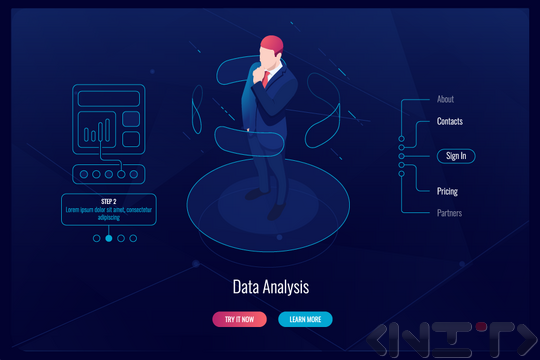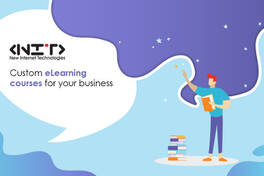
Approximate reading time: 8m 36s
What is virtual reality and how to use it in employee training.
Not surprisingly, more and more learning and development professionals are beginning to explore how virtual reality/VR training can fit into their organization's goals and into the company's internal LMS. This rapidly evolving training tool offers numerous benefits for both learners and organizations.
Hilton's Director of Learning Innovation calls VR "the future of learning." The Vice President of Global Education for Johnson & Johnson Medical Devices also notes the enormous potential of this technology, saying, "The world doesn't have enough access to safe healthcare because there aren't enough trained surgeons. Virtual reality tools can help solve this global crisis."
According to Wkipedia: Virtual reality is a term referring to an unreal world created through computer systems and audio-video equipment. It is an environment that does not physically exist but is created by information technology, so the shortest definition of it is "non-physical reality". The projection of images can be done not only on a monitor but also through stereoscopic glasses. Additional information is also given to the human senses through sound, which can be part of the simulation.
With many touting virtual reality as the next big "star" in the learning field, forward-thinking L&D leaders should familiarize themselves with the advantages, disadvantages, and different ways this technology can be used.
Benefits of using virtual reality in employee training
Virtual reality training uses realistic simulations to help employees learn new skills and develop existing ones. The trainee wears VR goggles that visually immerse them in computer-generated 3D graphics designed to mimic real-world environments. Typically, the team and motion controllers that allow the learner to interact with the virtual environment.
In the virtual environment, learners can perform activities and scenarios. These can range from technical skills exercises, such as learning to operate machinery, to soft skills exercises, such as de-escalating conflict when interacting with customers. This type of training offers several tangible advantages over traditional training formats.
Engagement
Employee engagement is one of the biggest challenges for L&D professionals. VR training helps to overcome this hurdle by creating a learning environment with minimal distractions where employees are empowered to control their experience.
Virtual reality engages the senses and immerses learners in a simulation of the real work environment, which can lead to better learning outcomes. A study by Stanford University and the Technical University of Denmark shows that VR training leads to a 76% increase in learning effectiveness compared to traditional training methods.
Virtual reality training resulted in a 76% increase in training effectiveness compared to traditional methods.
Another PricewaterhouseCoopers study compared VR training to traditional training and found that when practicing soft skills, VR simulations train learners faster and create a "stronger emotional connection" to the content
The better results obtained as a result of such immersive experiences reflect a basic tenet of adult learning theory - that adults learn best and retain information most in conditions that approximate the real world. In this case, VR training is able to facilitate "learning by doing," making learners more capable by giving them simulated, hands-on experience with tasks that they might otherwise have to read about or wait to be completed once they are at work.
Additionally, if learners need extra practice time to master a skill, they can repeat the same tasks repeatedly in a virtual environment at minimal additional cost.
Saving costs
Immersive learning eliminates distractions and allows learners to progress through training faster, saving organisations time and money. In fact, the aforementioned PwC study found that VR-trained employees learned up to four times faster than traditional classroom learners. Less downtime also means higher productivity, which adds value to an organization's financial performance.
Employees trained with VR learn up to 4 times faster than traditional classroom learners.
Despite the initial cost of investing in VR training technology (more on this below), studies show that using it to train large numbers of people over time can be more cost-effective than live simulations.
VR training also makes it easier to practice skills that carry a high degree of risk for expensive equipment. And when it comes to soft skills training, a simulated environment creates a safe space where failure does not have a detrimental impact on relationships with key stakeholders.
A better data set
VR training technology gives L&D teams better insight into learners' real-time analytics. Not only does it allow them to better assess content learning, but it also conveniently provides the data needed to continuously improve training interventions. Many VR solutions offer the following data:
- Usage statistics (frequency of training, duration and completion rate)
- Performance data (tasks completed, questions answered correctly)
- Engagement levels (measured by eye tracking, head movement, and other learner interactions)
Disadvantages of VR training
Although VR training can be a cost-effective solution, of course, the initial implementation costs must be taken into account. Although the rapid development of consumer-grade virtual reality devices is more affordable now, VR training still has large development and deployment costs associated with it.
According to one estimate, the average cost of designing, creating, and managing a full VR training program is between US$40,000 and US$155,000. This estimate varies widely depending on the scope of the training and whether organizations need to outsource some of the work.
The average cost of a VR training program is between 40,000 and 155,000 USD in the US.
Some industries require uniquely developed features that standard VR controllers do not offer. To make VR training as realistic as possible, developers may decide to create specialized controllers to match equipment used in real life. Additionally, as technology advances, organizations may need to upgrade their VR hardware.
In addition to its high cost, VR training has technological limitations. One example is the screen effect - when someone wearing virtual reality goggles can see individual pixels due to the fact that they are viewing an electronic screen from such a close distance. And sometimes artificial intelligence fails to act as a real person would in a similar environment because of poor simulation design. These limitations remind learners that they are in a simulated environment, which can lead to virtual fatigue. In some cases, learners may also experience symptoms of seasickness while wearing VR equipment.
Therefore, VR content is created in chunks, limiting training time with VR goggles to 20 minutes. This is exactly why shorter training sessions and regular breaks can help overcome virtual fatigue as well. Training developers should create VR content with limited training time to 20 minutes or less; furthermore, they should offer non-VR content that complements simulated training. Not only can this help with potential physical limitations, but it also ensures that VR training meets the microlearning preferences of today's workforce.
Using VR for employee training
Developing a VR training program doesn't happen overnight. There are many components of VR training development, from instructional design to 3D modeling, that go into trying to make the virtual experience as realistic as possible.
While it's easy to get carried away with any new technology, training developers should keep in mind that VR is an additional tool. Traditional training methods are still necessary and can be used in combination with VR to create a more complete and successful training plan.
Here are a few ways large organizations are leveraging this innovative technology and harnessing its power to develop their workforce.
Verizon
Verizon offers VR training to teach call center employees how to de-escalate difficult customer service calls. During the training, associates practice both leading conversations and active listening. Not only does the module drastically reduce training time, but Verizon's global director of L&D says employees are "much more confident because [they are] more self-aware in the way [they] deal with the customer."
Walmart
All Walmart stores are equipped with virtual reality goggles for virtual reality and the company reports that it has trained over one million of its employees with them. The training includes everything from a module called "The Pickup Tower," in which associates learn how to operate a kiosk to pick up online orders, to active shooter training modules. Because technology has helped reduce training time, Walmart estimates that VR has returned "over one million full workdays."
FedEx
FedEx offers VR training on how to work in the warehouse and how to properly load and unload trailers. The managing director of Ground University, FedEx's corporate training program, says some of the things that are simulated in VR are impossible to do in a typical classroom.
Porsche
In the transition to an electrified future, Porsche has created VR training for electric cars and the technology behind them. It involves looking through a training catalogue, interacting with displays of electrical components and checking mastery through an interactive test. Additionally, this training has the ability to be delivered without VR, via a web browser, making it easy to access and share across the Porsche enterprise.
Henkel
Chemical and consumer goods company Henkel has developed VR training for workplace health and safety. What helps make this training effective is that trainees are presented with real-world conditions and challenged to identify any risks before moving on to a new environment. This combination of immersion and gamification is where VR training excels.
Can VR technologies be integrated into modern learning management systems - LMS ?
Integrating virtual reality (VR) technologies into learning management systems enables enterprises to measure employee capabilities and determine where improvements can be made.
The number of VR applications across a wide range of industry sectors is increasing at a rapid pace. VR technology has gone beyond gaming and is making its way into the enterprise space.
One of the major benefits that organizations are finding is that when VR technologies are integrated into learning management systems (LMS), they have a profound effect on staff training.
While standard training methods are a self-contained experience that is difficult to monitor effectively, computer simulators enable trainers to collect data that answers questions about how competent they are.
But the huge difference with VR simulators is that employees are placed in a virtual environment with life-like experiences. When integrated into a learning management system, you have the ability to observe their performance mentally, physically and emotionally without any associated risk.
This also helps employees understand their strengths and weaknesses and introduces them to situations through which they can develop their skills faster and remember information more easily.
In fact, integrating virtual reality with your learning management system has numerous benefits:
- Takes employees beyond tick-box training and note-taking
- Low risk
- Increased personalization
- Visualization for better understanding and recall
- Increase user engagement
- Simplify complex procedures
- Simulate real-life scenariosIntegrate VR with eLearning management systems
Technology is having a huge impact on today's corporate world, and we are still in the early stages of development. Moving corporate training online and using VR to enhance training programs will move industries to the next level.
Cloud-based eLearning (xAPI) is already proving its worth as an effective training tool. Learning management systems enable companies to create amazing course content and measure competencies in a variety of areas.
On their own, however, LMSs only provide an academic test of employee abilities. Learner performance in an LMS, where intelligence is important to analyze, is not always reflected in the workplace, where initiative, people skills, and the ability to work under pressure may be needed.
Virtual reality takes the LMS to another level. With the ability to incorporate interactive elements into training programs, you can use online training tools to create replicas of scenarios they will actually encounter on the job.
By using VR to create realistic environments that mimic real-life scenarios, trainers and educators can use the LMS to observe learner response in real time. In addition, people learn much better when they have a visual representation and actually perform tasks for themselves.
For the human brain, it makes no difference whether the task you are performing is real or just simulated in an artificial environment. Virtual reality headsets work by effectively closing the senses to the outside world and promoting the illusion that the experience the user is having is really happening.
When you immerse yourself in a simulated environment with an almost identical level of reality, you can fool the brain into thinking the experience is real, and it will react accordingly.
This immediate feedback also gives trainers and educators a better insight into the learners; their temperament, their ability to handle tension, their management skills and any other potential scenarios you want to create.
How you can use VR in training programmes
Onboarding programs give each employee the opportunity to get used to performing tasks for the first time, which is extremely beneficial for employees. There are professions where virtual reality simulators are crucial, such as performing surgical procedures and working on rescue teams.
However, now that VR is ready for widespread adoption, the development of hardware and software products will evolve at a rapid pace. Industries will benefit from creating learning environments that can incorporate everything, including small details such as compliance and soft skills.
Companies are also required to provide staff training that goes beyond their day-to-day duties. For example, health and safety, first aid and fire training are legal requirements and for the most part are very boring.
Virtual reality adds a whole new dimension to these types of routine and mandatory training. You can physically turn passive training into active training by incorporating visual cues to highlight the most important aspects of the training program.
Virtual reality technology may have taken a long time to enter the mass markets, but it's here now, and corporate enterprises have an excellent opportunity to incorporate virtual reality technology into your learning management systems and improve all areas of your business.
If you would like to discuss how you can integrate VR into your learning management system, contact us.
Conclusion
There's plenty of evidence that virtual reality is here to stay: the global VR market is forecast to grow to over $12 billion by 2024, and the technology is expected to become mainstream in the next three to four years. As L&D leaders look to help their organizations prepare for the future, the time to start exploring VR training solutions is now.



